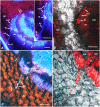Differences in stylet sheath occurrence and the fibrous ring (sclerenchyma) between xCitroncirus plants relatively resistant or susceptible to adults of the Asian citrus psyllid Diaphorina citri (Hemiptera: Liviidae)
- PMID: 25343712
- PMCID: PMC4208817
- DOI: 10.1371/journal.pone.0110919
Differences in stylet sheath occurrence and the fibrous ring (sclerenchyma) between xCitroncirus plants relatively resistant or susceptible to adults of the Asian citrus psyllid Diaphorina citri (Hemiptera: Liviidae)
Abstract
The Asian citrus psyllid (ACP, Diaphorina citri, Hemiptera: Liviidae), is the principal vector of the phloem-limited bacteria strongly associated with huanglongbing (HLB), the world's most serious disease of citrus. Host plant resistance may provide an environmentally safe and sustainable method of controlling ACP and/or HLB. Two xCitroncirus accessions (hybrids of Poncirus trifoliata and Citrus spp.), that are relatively resistant (UN-3881) or relatively susceptible (Troyer-1459) to ACP adults with regard to adult longevity, were compared in relation to ACP feeding behavior and some structural features of the leaf midrib. The settling (putative feeding/probing) sites of ACP adults on various parts of the leaf were not influenced primarily by plant accession. However, fewer ACP stylet sheaths were found in the midrib and fewer stylet sheath termini reached the vascular bundle (phloem and/or xylem) in UN-3881 compared to Troyer-1459 plants. Furthermore, in midribs of UN-3881 leaves the fibrous ring (sclerenchyma) around the phloem was significantly wider (thicker) compared to that in midribs of Troyer-1459 leaves. Our data indicate that feeding and/or probing by ACP adults into the vascular bundle is less frequent in the more resistant (UN-3881) than in the more susceptible (Troyer-1459) accessions. Our results also suggest that the thickness of the fibrous ring may be a barrier to stylet penetration into the vascular bundle, which is important for successful ACP feeding on the phloem and for transmitting HLB-associated bacteria. These results may help in the development of citrus plants resistant to ACP, which in turn could halt or slow the spread of the HLB-associated bacteria by this vector.
Conflict of interest statement
Figures




References
-
- Halbert SE, Manjunath KL (2004) Asian citrus psyllids (Sternorrhyncha: Psyllidae) and greening disease of citrus: A literature review and assessment of risk in Florida. Florida Entomologist 87: 330–353.
-
- Bove JM (2006) Huanglongbing: A destructive, newly-emerging, century-old disease of citrus. Journal of Plant Pathology 88: 7–37.
-
- Gottwald TR (2010) Current epidemiological understanding of citrus huanglongbing. Annual Review of Phytopathology 48: 119–139. - PubMed
-
- Hall DG, Richardson ML, Ammar E-D, Halbert SE (2013) Asian citrus psyllid, Diaphorina citri, vector of citrus huanglongbing disease. Entomologia Experimentalis Et Applicata 146: 207–223.
-
- Hall DG, Gottwald TR, Stover E, Beattie GAC (2013) Evaluation of management programs for protecting young citrus plantings from huanglongbing. HortScience 48: 330–337.
Publication types
MeSH terms
LinkOut - more resources
Full Text Sources
Other Literature Sources
Miscellaneous

